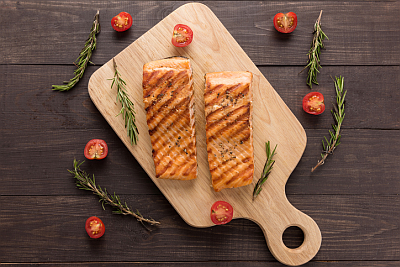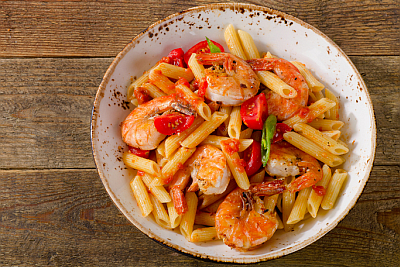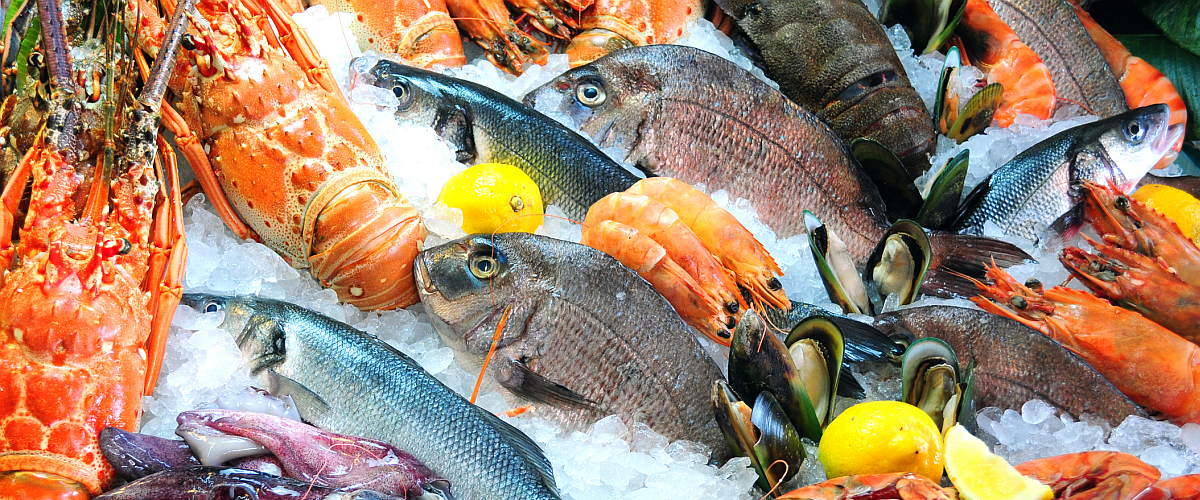From tilapia to trout and crab to cod, incorporating seafood into your diet is a wonderful way to feed your potential any time of year. When you consider seafood’s lean protein, healthy fat, and range of nutritional and heart health benefits, it’s easy to see why. Read on to learn more about seafood’s benefits, and get recipe ideas sure to make a splash.
Eat Up for Your Health
Fish and other seafood are among the healthiest foods on the planet, in part because they’re a rich source of heart-healthy omega-3 fatty acids.
 “Omega-3’s are essential fats, which means the body can’t make them from scratch, but must get them from foods like fish, seeds, nuts and vegetable oils,” says Aramark registered dietitian Amanda Rose, pictured. “Research shows that these unsaturated ‘good’ fats provide numerous health benefits.”
“Omega-3’s are essential fats, which means the body can’t make them from scratch, but must get them from foods like fish, seeds, nuts and vegetable oils,” says Aramark registered dietitian Amanda Rose, pictured. “Research shows that these unsaturated ‘good’ fats provide numerous health benefits.”
In fact, the American Heart Association (AHA) reports that as part of a heart-healthy diet, eating fish with their omega-3’s can help reduce the risk of heart failure, coronary heart disease, cardiac arrest and the most common type of stroke. Look for salmon, herring, mackerel and other fatty types of fish as they contain high amounts of omega-3’s.
But healthful fats are not the only reason to eat fish! Fish and other seafood also provide other important nutrients. In fact, dietary guidelines in the United States encourage adults to eat a variety of fish and seafood each week because of the “total package of nutrients in fish,” which includes lean protein, vitamins A and D as well as B vitamins, and a number of minerals such as iron, zinc and selenium.
“Fish is also very low in saturated fat and lower in cholesterol compared to meat and poultry,” says Amanda. “It can be a much leaner, lower calorie source of protein than meat, as well.”
Go Fish, Twice a Week
The AHA recommends eating at least two 3.5-ounce servings of fish (particularly fatty fish) per week*. This recommendation reflects the overall positives of eating fish and the specific health benefits of two servings each week of the unsaturated omega-3 fatty acids found in seafood.
Remember shellfish like oysters, mussels, and clams, and even calamari all count, so think beyond the fish fillet. Whatever you choose, it’s easy to keep things lean and flavorful. Try grilling, broiling, roasting, or baking your fish using healthy olive or vegetable oils and using spices or herbs, such as dill, or lemon or lime juice to add flavor without adding salt.
Think Sustainably Sourced
Need a bit more guidance on what to buy? “Choosing sustainably sourced seafood is actually one way you can help our planet stay healthy,” says Kathy Cacciola, Aramark Senior Director of Environmental Sustainability, pictured. “Sustainable seafood comes from fish or shellfish species that are caught or farmed in ways that support healthy marine life populations and ecosystems.”
Since 2008, Aramark has partnered with the Monterey Bay Aquarium’s Seafood Watch program to responsibly source sustainable seafood. Some results? By early 2018, 90% of our frozen finfish and 100% of our canned tuna purchases met the Seafood Watch recommendations, and by the end of 2018, we expect to have transitioned all salmon and shrimp to Seafood Watch Best Choice and Good Alternative categories.
Dive Into These Dishes
Not sure about the best way to cook seafood at home? We’ve added two delicious (and nearly foolproof) recipes here to get you swimming in the right direction.
Garlic Grilled Salmon (Serves 6)
Especially delicious served right off the grill, this salmon stays moist inside, with a slightly crispy, smoky outside. Coat the grill rack with oil or  cooking spray before adding the fish for an easier flip and serve.
cooking spray before adding the fish for an easier flip and serve.
6 wild Pacific salmon loins (or fillet), about 4 oz. each (thawed if frozen)
2 Tbsp vegetable or olive oil
1-2 cloves garlic, peeled and minced
1/8 tsp kosher salt
1/8 tsp freshly ground black pepper
Instructions
- Preheat char-grill to medium-high.
- Gently toss salmon with oil, garlic, salt and pepper.
- Grill salmon 2-3 minutes on each side until internal temperature reaches 145oF.
Spicy Shrimp and Penne (6 Servings)
Say goodbye to traditional pasta and hello to this seafood sensation. Tossed in a roasted garlic-lemon broth, there’s also a peppery kick.
1 1/2 tsp olive oil
12 oz. raw shrimp, peeled and deveined (thawed if frozen) – choose a Seafood Watch Best Choice, like giant freshwater or tiger shrimp, or go to seafoodwatch.org to find other eco-friendly sources.
3 Tbsp fresh green onion (scallion), trimmed and thinly sliced
2 cups roasted diced tomatoes in can, drained
1/2 cup roasted peppers, drained and chopped
1/2 tsp crushed red chili pepper flakes (or to taste)
3/4 tsp kosher salt
3/4 tsp freshly ground black pepper
3 cups roasted garlic-lemon broth (recipe follows)
6 cups whole grain penne pasta, cooked al dente according to package directions and drained (about 12 ounces dry pasta, uncooked)
1 Tbsp fresh basil leaves, chopped or sliced into ribbons
3 oz. shredded Parmesan cheese (about 1/3 cup), divided
Instructions:
- In large sauté pan over medium-high heat, heat olive oil.
- Add shrimp and scallion; sauté 1 minute, stirring.
- Add to pan roasted tomatoes, roasted peppers, chili peppers, salt, pepper and garlic-lemon broth. Mix well and simmer until heated through, about 1 minute.
- Add penne, basil and half of Parmesan cheese. Toss to coat and simmer until heated through.
- Divide into six portions; top each serving with remaining Parmesan cheese and whole basil leaves if desired.
Roasted Garlic-Lemon Broth
2 cloves fresh garlic, peeled
1/4 tsp olive oil
2 Tbsp water
2 Tbsp cornstarch
2 3/4 cups low sodium vegetable broth
3 Tbsp fresh lemon juice
1 1/2 tsp freshly grated lemon zest
Instructions
- Heat oven to 350oF
- Coat garlic with olive oil, wrap in foil and roast in hot oven until garlic is soft and golden, 25-30 minutes.
- Remove roasted garlic and mash or puree in blender or food processor.
- In small bowl, whisk together water and cornstarch until well blended. Set aside.
- In a stockpot over medium-high heat, bring to a boil broth, pureed garlic, lemon juice and lemon zest. Reduce heat.
- Add cornstarch-water mixture, whisking constantly, until broth thickens and simmers, about 5 minutes.
- Keep hot for recipe.
*Notes:
Experts generally recommend that fish be included twice a week in a balanced diet. For some, however, eating too much seafood can be a health risk. Current federal guidelines advise women who are pregnant or who plan to become pregnant, nursing mothers, and children under 12 to avoid fish that may contain high mercury levels such as shark, tilefish, albacore tuna and king mackerel. Also, pregnant women and people who are at greater risk for foodborne illness should not eat raw or undercooked seafood. Everyone should avoid over-consumption and vary the types of fish eaten as a way to avoid potential issues associated with any single fish species.
Note: Since everyone’s health history and nutritional needs are so different, please make sure that you talk with your doctor and a registered dietitian to get advice about the diet and exercise plan that‘s right for you.

